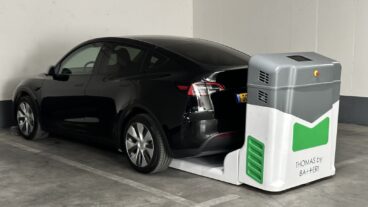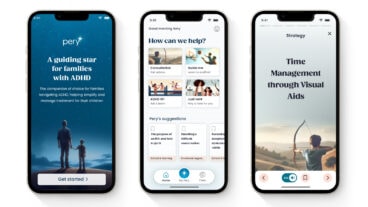3DVU supplies your GPS with visually stimulating 3D images that will chart a driver’s progress on the road in real time, allowing you to anticipate traffic, road closures and other obstacles that make driving difficult.Watch a TV commercial for a car made by Ford, GM, Nissan, Toyota and all the rest, and you’d think that driving was the most exciting pastime in the world. The open road, zipping through meadows and valleys, the feeling of freedom – you just can’t wait to run down to the dealership and plunk down $25,000 or so for the latest and greatest Detroit or Tokyo has to offer.
But anyone who’s driven for any length of time knows that taking the wheel is often an exercise in frustration. You’re tortured by traffic, vagrants, and timed traffic lights in the city, while out on the Interstate, you face endless miles of concrete, construction, more traffic, kids’ cries of “are we there yet,” and state troopers just itching to give you a ticket. After a couple of hours behind the wheel, many drivers find their blood pressure rising – resulting in either varying degrees of road rage or the “highway zone out,” where bleary eyed drivers do dumb things that can get them in trouble – or worse.
Isaac Levanon, founder and CEO of Israeli startup 3DVU (pronounced 3D View), feels your pain – and wants to make driving an experience easier on the head and the heart. No, he can’t promise you glorious open vistas all the way through, nor can he protect you from the highway patrol. But he can supply your car’s GPS with very cool 3D images that will chart your progress on the road – in real time, allowing you to anticipate traffic, road closures, hairpin curves, and other obstacles that frustrate or bore, ensuring that you get where you have to go safely and securely.
How does a driver get his or her bearings on the road? How do they know where they are, or where they’re going? And how do they figure out how much more time they’ll be stuck behind the wheel? Well, the “old tech” way was to use a map; but maps are dull, and they give almost no information on the actual conditions drivers face on the road. If you’re driving in, say, Barcelona, Levanon says, a map won’t do you much good.
“All traffic circles in maps of Barcelona look the same – a drawing of a circle, in color. But in real life, each circle has a different fountain,” he told ISRAEl21c.
The “new tech” way, which Levanon says represents a vast improvement over maps, is the use of a satellite-based Global Positioning System device. GPS devices hone in on satellites revolving around the earth and download maps, often with real time traffic conditions, information about local services (gas stations, restaurants, etc.), and even renditions of what drivers can expect to see further on down the highway.
Good, but could be better, says Levanon. Most GPS renderings are little better than a 2D map. They are boring to look at, often drawn in single colors, and have a “single direction” line, in which you appear to be going the right way northbound on the road but backwards when driving south. In general, says Levanon, they offer a poor implementation “of the power of digital media.”
What’s needed, Levanon says, is more interest, such as 3D renderings of what drivers can expect to see along the way. It’s a far more interesting perspective on the world, one that can keep drivers more alert, and, as a result, safer.
According to Levanon, 3DVU’s solution, called Navi2Go, will “replace today’s dull maps with rich, color imagery at higher resolution including terrain that is fun to view and fly over. It will solve one of the most fundamental challenges that effects maps: landmark navigation.”
In fact, 3DVU’s Navi2Go Web site has a demo showing exactly what users of the company’s technology can expect. Using GPS satellites, the company’s technology shows drivers where they are at any given time, with their route laid out, and “flyover” perspectives of their position and destination, as well as what’s in between.
So how did Levanon come up with such a great idea? It seems as if he has been preparing for something like 3DVU for most of his 25 years in the tech business, and even before. He was a pilot in the Israeli Air Force, which gave him a “long-distance” perspective on the importance of observing and anticipating the terrain and physical conditions he would be facing on journeys – an idea he’s transferred to road navigation with 3DVU.
If Levanon’s maps look suspiciously like video games, that’s because the technology does indeed have its roots in game technology, he says. Navi2Go’s maps will sync with the experiences of younger drivers especially, he says.
“Generation X and Y will view maps and fly over terrain just as they do in the video games they have grown up with,” he said.
The original rendition of the technology, called FlyOver, “started from playing a game with a 3D engine that allows users to maneuver over an object. I thought that mapping an image over the object would make a better impression, so we took an aerial photo and played with it. We realized that it is really cool and very intuitive. It took me some time to realize the potential of the software we had developed and to start FlyOver. This happened in March 2000 and I haven’t slept since,” Levanon said.
Levanon says that the first GPS devices with Navi2Go built in will be available in a few months. Such devices have been in use in the 3DVU’s first target market, Japan, for several years already, and have been very well received. The company has deals with some of the biggest names in the automotive market – Denso, Kenwood, and others – and once the first devices hit the American market, 3DVU will turn its attention to the UK and Israel, developing the detailed maps for drivers using GPS devices in both countries, by years’ end.
And, Levanon says, the company is developing GPS-like solutions for other devices as well – like cell phones, PDAs, and handheld Personal Navigation Devices now under development, which will allow joggers, bikers, boaters and other participants in outdoor activities to utilize 3DVU’s technology as well.
3DVU has won numerous awards for its technology, and the Ra’anana-based company anticipates a major market breakthrough in the coming months. To Levanon, the technology he’s come up with is a sure winner: Once drivers get exposed to the beautiful 3D renderings of Navi2Go, replacing the squiggly lines on a map or an old-fashioned GPS, there’ll be no turning back. “Would you give up your color TV for a black and white set,” he asks? “I don’t think so!”![]()
Slashdot It!![]()












